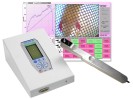Authors
C. Reali, P. Fossat, M. Landry, R. Russo, F. Nagy.
Lab
Université de Bordeaux, Neurocentre Magendie, Bordeaux, France.
Journal
The Journal of Physiology
Abstract
The dorsal horn of the spinal cord is the first central relay where nociceptive inputs are processed. Based on the expression and modulation of intrinsic electrophysiological properties in in vitro slice preparations, dorsal horn neurones (DHNs) display different discharge patterns (tonic, plateau or rhythmic), which shape the neurone's response to sensory inputs. However, it is unclear whether intrinsic properties play any role in sensory processing in vivo. Using in vivo patch clamp recordings in the adult rat, we here examine whether these intrinsic properties are present, and to what extent they determine the DHN response to natural stimulation. We focused primarily on wide dynamic range neurones in deep laminae. These cells displayed a multicomponent peripheral receptive field, comprising an excitatory firing zone, a low-probability firing fringe, and adjacent inhibitory zones. Deep DHNs presented similar intrinsic properties to those observed in vitro, including plateau potentials. These plateaus, underlying high frequency accelerating discharges and after-discharges, were triggered by mechanical stimulation of the excitatory receptive field. Persistent activities induced by activation of plateau potentials were interrupted by stimulation of peripheral inhibitory zones. Moreover, we show that plateau activation is necessary for the expression of windup in response to repetitive, nociceptive stimulation. Finally, using the spinal nerve ligation model of neuropathy, we demonstrate a significant increase in the proportion of plateau neurones in deep dorsal laminae. Our data, therefore, establish that intrinsic amplification properties are expressed within intact spinal circuits and suggest their involvement in neuropathy-induced hyperexcitability of deep DHNs.
BIOSEB Instruments Used:
Electronic Von Frey 4 (BIO-EVF4),Electronic Von Frey 5 with embedded camera (BIO-EVF5)

 Pain - Thermal Allodynia / Hyperalgesia
Pain - Thermal Allodynia / Hyperalgesia Pain - Spontaneous Pain - Postural Deficit
Pain - Spontaneous Pain - Postural Deficit Pain - Mechanical Allodynia / Hyperalgesia
Pain - Mechanical Allodynia / Hyperalgesia Learning/Memory - Attention - Addiction
Learning/Memory - Attention - Addiction Physiology & Respiratory Research
Physiology & Respiratory Research
 Pain
Pain Metabolism
Metabolism Motor control
Motor control Neurodegeneration
Neurodegeneration Cross-disciplinary subjects
Cross-disciplinary subjects Muscular system
Muscular system General activity
General activity Mood Disorders
Mood Disorders Other disorders
Other disorders Joints
Joints Central Nervous System (CNS)
Central Nervous System (CNS) Sensory system
Sensory system Bioseb on booth #14 at OARSI 2024 in Vienna
Bioseb on booth #14 at OARSI 2024 in Vienna 
